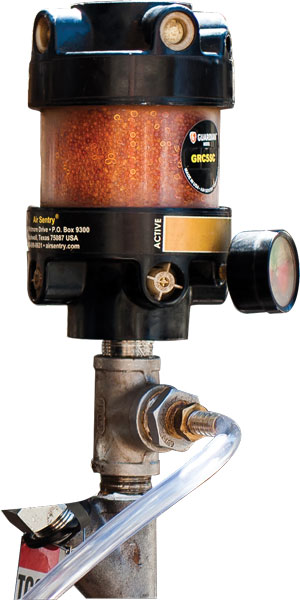Lube-Tips
 Advice for Greasing Electric Motors
Advice for Greasing Electric Motors
When using an audible or ultrasonic grease gun attachment for lubricating motors, be sure that the motor grease ftting tube and grease gun coupler do not touch the rear fan bell section of the motor or the coupling guard at the front of the motor. If there is any touching in these areas (even just the paint), the bearing noise is not likely to be the dominant sound heard or registered on the meter. To get a true reading, you may have to snap the coupler to the Zerk and pull it away from the contact zone while greasing. A pistol-grip grease gun will make this easier.
Copper Levels Indicate Problems
Copper readings can be particularly alarming when increases are in the hundreds of parts per million. However, huge increases are typically insignifcant in terms of component wear. Ironically, subtle increases in copper are of a higher concern and should be examined closely. Copper alloy component wear is generally accompanied by lock-step increases in alloy metals such as lead, tin, aluminum and zinc. The amount of alloy metal present in brass/bronze components is only a small percentage of the total copper content. Changes in these alloys may be only a few parts per million but should be taken seriously when present with copper increases.
Laser Level Lube Check
To determine the correct oil level in rotating equipment, use a laser level technique. First, determine the center line of the shaft and inscribe a line on the outside of the housing representing this point. Next, measure down one-half of the bearing pitch diameter (mean diameter) and inscribe another line. The pitch diameter is the bore diameter plus the outside diameter divided by two. The lower inscribed line would be halfway up the lowest rolling element. Project the laser line to this lower inscribed line representing the correct oil level.
Check Grease Compatibility
When selecting a grease, always consider the base or thickener. Many thickeners are not compatible, such as lithium complex and bentone. When combined, the bases soften, and the lubricating oil pools and drops away from the bearing. Even if both greases are listed as general-purpose grease and have the same NLGI designation, viscosity index, work stability, dropping point, etc., don’t assume they are the same. Non-compatible greases will contribute to lubrication failure in bearings. So check a compatibility chart to know if the grease you intend to use is compatible with the grease in the machine.
Filter Change Reminder
When installing particulate-type breathers, use a Sharpie marker to write the month and year of installation on the breather. Then you can easily see when you make your weekly checks which ones need to be changed.
Caution on Gearbox Retrofits
When retroftting gearboxes for service and fltering, consider using stainlesssteel piping instead of black iron piping. After a short period of time, the inside of the black piping begins to crust and flake off into the gearboxes, giving false test results. This is more predominant in high humidity and frequent washdown areas.
Seal the Deal on Breathers
Keeping water out of oil seems to be a never-ending battle. Water may well be the No. 1 contaminant, reducing run-to-failure time by a factor of 10. Breathers with threads may allow water to wick its way down the threads, contaminating the lubricant. Other forms of contamination such as rust and wear particles can develop around the threads. Air gaps between the threads form a hiding place where rust can develop. Overtightening with a wrench may stop water ingression but can cause pieces of thread to spall off and fall into the lubricant. Placing a small amount of thread sealant on all breathers using pipe threads will greatly reduce this risk. Thread sealant will fll the air gaps, lubricate the threads and seal out the water.
